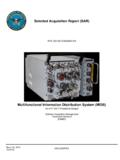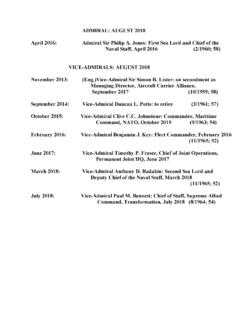Transcription of The Army's Armored Multi-Purpose Vehicle (AMPV ...
1 The Army s Armored Multi-Purpose Vehicle (AMPV): Background and Issues for Congress Andrew Feickert Specialist in Military Ground Forces March 9, 2018 Congressional Research Service 7-5700 R43240 The Army s Armored Multi-Purpose Vehicle (AMPV): Background and Issues for Congress Congressional Research Service Summary The Armored Multi-Purpose Vehicle (AMPV) is the Army s proposed replacement for the Vietnam-era M-113 personnel carriers, which are still in service in a variety of support capacities in Armored Brigade Combat Teams (ABCTs). While M-113s no longer serve as infantry fighting vehicles, five variants of the M-113 are used as command and control vehicles, general purpose vehicles, mortar carriers, and medical treatment and evacuation vehicles.
2 The AMPV is intended to be a non-developmental program (candidate vehicles will be either existing vehicles or modified existing vehicles not vehicles that are specially designed and not currently in service). Some suggest a non-developmental Vehicle might make it easier for the Army to eventually field this system to the force, as most of the Army s past developmental programs, such as the Ground Combat Vehicle (GCV), the Future Combat System (FCS), the Crusader self-propelled artillery system, and the Comanche helicopter, were cancelled before they could be fully developed and fielded.
3 On November 26, 2013, the Army issued a Request for Proposal (RFP) for the AMPV. This RFP stipulated the Army planned to award a five-year Engineering and Manufacturing Development (EMD) contract in May 2014 worth $458 million to a single contractor for 29 prototypes. While the March 2013 RFP established an Average Unit Manufacturing Cost Ceiling for each AMPV at $ million, this was rescinded to permit vendors greater flexibility. The EMD phase was scheduled to run between FY2015 and FY2019, followed by three years of low-rate initial production (LRIP) starting in 2020.
4 As of 2017, the Army planned to procure 2,936 AMPVs to replace M-113s in ABCTs. The Army also has plans to replace 1,922 M-113s at Echelons Above Brigade (EAB), and Department of Defense (DOD) estimates if the M-113s are replaced by AMPVs at EAB, total program costs could be increased by an additional $ billion. While the Army would like a pure fleet of AMPVs, budgetary constraints could preclude this. On December 23, 2014, the Army announced it had selected BAE Systems Land and Armaments as the winner of the EMD contract. The initial award was for 52 months, valued at about $382 million.
5 In addition, the award provides for an optional Low-Rate Initial Production (LRIP) phase. If this phase is awarded, BAE would produce an additional 289 vehicles for a total contract value of $ billion. This EMD contract does not include EAB AMPV variants. The AMPV reportedly successfully completed its Critical Design Review (CDR) on June 23, 2016. On December 15, 2016, BAE delivered the first general purpose AMPV to the Army for testing. In September 2017, the Army began AMPV reliability, availability, and maintainability (RAM) testing. Also in 2017, based on budgetary constraints, the Army decided that it would upgrade a number of EAB M-113s instead of replacing them with AMPVs.
6 Other program issues include DOD Inspector General (IG) concerns regarding performance and design concerns, as well as inaccurate procurement quantities, which could result in inaccurate program costs. Another issue addressed in the FY2018 National Defense Authorization Act is funding restrictions on M-113 upgrades until the Secretary of the Army provides the defense committees with a report on its strategy to upgrade EAB M-113s. The FY2019 AMPV budget request is $ million for the production of 197 vehicles. Potential issues for Congress include upgraded M-113s at EAB and DOD Inspector General (IG) concerns.
7 The Army s Armored Multi-Purpose Vehicle (AMPV): Background and Issues for Congress Congressional Research Service Contents Background .. 1 The Armored Multi-Purpose Vehicle (AMPV) .. 1 The Army s AMPV Requirements .. 1 AMPVs at Echelons Above Brigade (EAB) .. 2 Program Overview .. 2 Department of Defense (DOD) Approves AMPV Program .. 3 Army Issues AMPV Draft Request for Proposal (RFP) .. 3 2017 ABCT AMPV Procurement Quantities .. 3 Selected Program Activities .. 3 Army Awards ABCT AMPV Contract to BAE .. 3 AMPV Completes Critical Design Review.
8 4 Roll Out of First AMPV for Testing .. 4 AMPV Begins Developmental Testing .. 4 Army Plans to Limit EAB Upgraded M-113 Numbers .. 5 Other Program Issues .. 5 DOD Inspector General (IG) Concerns .. 5 FY2018 National Defense Authorization Act (NDAA) 115-91 .. 5 Department of Defense FY2019 AMPV Budget Request .. 6 Potential Issues for 7 Upgraded M-113s at Echelons Above Brigade (EAB) .. 7 DOD Inspector General (IG) Concerns .. 7 Tables Table 1. M-113 Distribution in ABCTs, by Variant .. 2 Table 2. FY2019 AMPV Budget Request .. 6 Contacts Author Contact Information.
9 7 The Army s Armored Multi-Purpose Vehicle (AMPV): Background and Issues for Congress Congressional Research Service 1 Background In 1956, the Army began the development of a family of air-transportable, Armored Multi-Purpose vehicles intended to provide a lightweight, amphibious Armored personnel carrier for armor and mechanized infantry Known as the M-113, it entered production in 1960 and saw extensive wartime service in Vietnam. Considered a reliable and versatile Vehicle , a number of different variations of the M-113 were produced to fulfill such roles as a command and control Vehicle , mortar carrier, and Armored ambulance, to name but a few.
10 The Army began replacing the M-113 infantry carrier version in the early 1980s with the M-2 Bradley Infantry Fighting Vehicle , but many non-infantry carrier versions of the M-113 were retained in service. The Armored Multi-Purpose Vehicle (AMPV)2 According to the Army: The Armored Multi-Purpose Vehicle (AMPV) is the proposed United States Army program for replacement of the M-113 Family of Vehicles (FOV) to mitigate current and future capability gaps in force protection, mobility, reliability, and interoperability by mission role variant within the Heavy Brigade Combat Team (HBCT) [now known as the Armored Brigade Combat Team ABCT].













